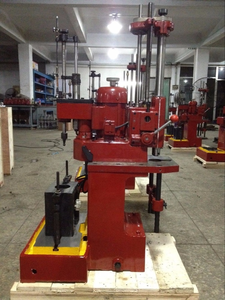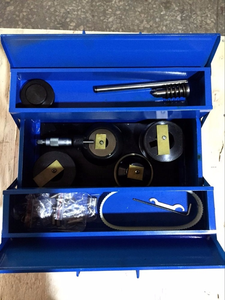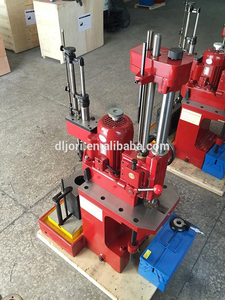
All categories
Featured selections
Trade Assurance
Buyer Central
Help Center
Get the app
Become a supplier

(3465 products available)




















































A hand bore machine is a type of machine used to create holes of various sizes in wood, metal, or other materials by rotating a cutting bit. Hand bore machines are divided into two main types by power source: manual hand bore machines and electric hand bore machines.
This subtype of hand bore machine works by pushing the bit into the material to be drilled. Depending on the design, some models have a trigger while others have a button to start the drilling process. This is a very common type of hand bore machine, and it is normally applicable to wood.
The other subtype of this kind of machine works by pulling the bit into the material. Similar to the push-to-start model, it also has a trigger or a button to control the operation. This type of hand bore machine is suitable for various materials, such as wood, metal, and plastic.
As with other types of machinery, it is important to consider the specifications and maintenance strategies for the portable line boring machine and other kinds of hand bore machines. Doing so will help prolong the equipment's life cycle and ensure consistent performance.
Work Range: This indicates the size of the bore machine's workings. It is typically given as a diameter range in mm or inches. For instance, a hand bore machine may have a work range of 50-400 mm, indicating that it can be used for bores within this diameter range. A machine with a larger work range can handle bigger jobs but might be heavier and more difficult to use.
Boring Bar Diameter: This is the diameter of the cutting tool in the hand bore machine. It is given in millimeters or inches and is usually between 25 mm (1 inch) and 100 mm (4 inches). Hand bore machines with larger boring bar diameters can remove more material per pass and are more suitable for larger bores and stronger materials.
Spindle Speed: This is the rotation speed of the spindle, which is the part of the machine that holds and rotates the boring bar. It is usually given in revolutions per minute (rpm) and can vary depending on the type and model of the hand bore machine. A higher spindle speed allows for faster and more efficient cutting but may require more power.
Feed Rate: This is the speed at which the cutting tool advances into the workpiece. It is usually given in millimeters per revolution (mm/rev) and can be adjusted to control the depth of cut and ensure optimal cutting performance.
Power: ThPower: This refers to the overall power of the machine. Motor power, in particular, is a crucial consideration when choosing a line boring machine. Motor power is typically measured in watt or kilowatts. Higher motor power allows the machine to cut through tough materials more efficiently and faster. The power of the line boring machine must be matched with the workpieces and the cutting requirements to ensure the work is done smoothly and with the desired result.
Regular Inspection: Before and after the use of the engine, all parts of the machine should be inspected to determine if there is any abnormality. If any irregularities are found, they should be dealt with promptly. For the parts that need to be lubricated, the oil should be added to ensure the normal operation of the engine.
Lubrication: The engine should be added with lubricating oil to reduce the friction between the moving parts and ensure the normal operation of the engine.
Cleaning: The engine should be cleaned regularly to remove dust, debris, and other contaminants. This will help to ensure the cooling and exhaust of the engine system are clean and prevent the failure of the engine due to overheating.
Preventive Maintenance: In addition to routine maintenance, it is also important to perform regular preventive maintenance on the engine, such as replacing the filter, checking the performance of the spark plug, etc. This will help to identify potential problems and address them before they become major issues.
Hand bore machines are useful tools in various industries and applications that require boring, trimming, or enlarging holes. Here are some of the scenarios in which they are used:
The hand bore machine is used to make holes in wood for screws, dowels, and other fasteners. In addition, it is used to make holes for mortising, joinery, and other woodworking techniques.
In metalworking, hand bore machines are used to drill precise holes in metal materials, such as steel, aluminum, and brass. This machine is used in metalworking to create bolt holes, pipe fittings, and other precision holes.
Hand bore machines are commonly used in construction and installation for drilling holes in materials such as concrete, masonry, and stone. These machines can be used to create anchor holes, cable passages, and plumbing chases.
In the automotive and aerospace industries, hand bore machines are used to drill precision holes in vehicle components or aircraft parts. These machines are used in the automotive and aerospace industries to produce accurate holes for assembly, fastening, and component integration.
Hand bore machines are also commonly used for DIY projects, such as home repairs, furniture assembly, and other crafts. This machine allows hobbyists and homeowners to drill holes and create custom projects without the need for advanced tools.
Hand bore machines are also used in field services and repairs to drill holes, make repairs, and conduct maintenance tasks on-site. These hand-powered machines provide flexibility and portability for use in remote locations or emergency repair situations.
When looking for a hand bore machine for sale, it is important to consider the different types of hand bore machines and their features and benefits. As highlighted in the previous paragraph, there are numerous types of hand bore machines. The first step to choosing the right hand bore machine for a business is to familiarize oneself with these types. Additionally, it is important to consider the needs and requirements of the business. Assess the materials that will be worked on and the type of bore required. Once the type of hand bore machine has been established, the next step is to consider the specifications of the machine. This includes the capacity, spindle speed, and other features that have been mentioned in the previous paragraph.
It is important to select a machine that can handle the anticipated workload. Furthermore, it is important to choose a hand bore machine that is built to last. Ensure that the machine is constructed from high-quality materials and has a solid and durable design. In addition to this, one should also look for a hand bore machine that has ergonomic features, which will make it easy to operate and reduce operator fatigue. Moreover, when looking for a hand bore machine for sale, it is important to buy a machine that has safety features. Ensuring the safety of the operators should be a top priority for businesses. As highlighted in the previous paragraph, some safety features to look out for include automatic shut-off mechanisms, safety guards, and emergency stop buttons.
It is also important to get a hand bore machine that can be easily serviced and maintained. This will help keep the machine in good working order and minimize downtime. Furthermore, when looking for a hand bore machine for sale, it is also important to consider the budget of the business. Typically, the cost of a hand bore machine will depend on its type, size, brand, and specifications. One should compare prices from different suppliers and choose a machine that offers good value for money.
Q1: What is the critical difference between a vertical and a horizontal boring machine?
A1: The primary difference between the horizontal and vertical hand bore machine is their design and the direction in which they operate. As a result, their applications and workpiece setup also differ. In general, a horizontal boring machine is more suitable for heavier workpieces, while a vertical machine is more appropriate for delicate workpieces.
Q2: What is the critical difference between a hand-held line boring machine and a hand-operated machine?
A2: A hand-operated line boring machine is typically mounted on a workpiece, while a hand-held machine is held manually. This means that users can move the machine across the workpiece to make borings at different points. However, this can be done manually by operating the hand-held machine. Hence, the hand-operated line boring machine is more suitable for larger workpieces that need bore holes at various points. On the other hand, a hand-held machine is ideal for mobility and smaller workpieces.
Q3: Is it possible to get a custom-designed boring machine?
A3: Many manufacturers offer customization options. Some of the features that can be customized include the size of the machine, the power source, additional tools, and specific technical specifications.